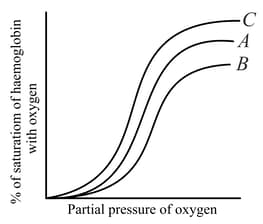EASY
Earn 100
The process of migration of chloride ions from plasma to RBC and of carbonate ions from RBC to plasma is:
(a)Chloride shift
(b)Ionic shift
(c)Atomic shift
(d)Na+ pump
69.23% studentsanswered this correctly
Important Questions on Breathing and Exchange of Gases
EASY
EASY
EASY
EASY
MEDIUM
EASY
MEDIUM
Study the following forms of transport of respiratory gases
A) as bicarbonates
B) through plasma
C) as carbamino compounds
D) through
E) in a dissolved state
Arrange the above in sequence in ascending order based on their percentages.
EASY
EASY
EASY
MEDIUM
In the given graph curves and represent the relation between partial pressure of oxygen and saturation of haemoglobin with oxygen. If curve represents the condition of blood in a regular artery then please select the correct statement from below.

EASY
MEDIUM
Select the favourable conditions required for the formation of oxyhaemoglobin at the alveoli.
EASY
EASY
EASY
MEDIUM
EASY
MEDIUM
MEDIUM

